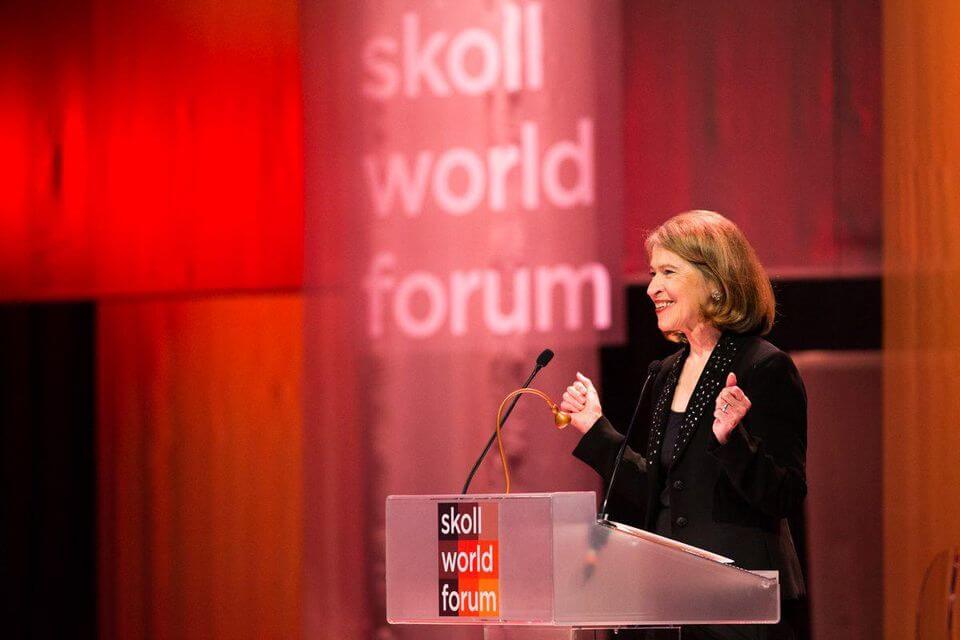‘Unparalleled Leadership’: Lessons from the CEO of a Top Children’s Hospital
In April, when Congresswoman Anna Eshoo took the floor of the U.S. House of Representatives to express her gratitude to Christopher Dawes on the occasion of his retirement as president and CEO of Lucile Packard Children’s Hospital Stanford and Stanford Children’s Health, she began by citing some of his many accomplishments.
Dawes, she explained, had a long and distinguished career in hospital management before joining Lucile Packard Children’s Hospital (“Packard Children’s”), which is affiliated with Stanford University, in 1991. He became the COO in 1995 and assumed the role of president and CEO in 1999. During his tenure in that role, Packard Children’s was consistently ranked as one of the best children’s hospitals in the United States; created nationally ranked clinical services; invested in the Children’s Health Research Institute; established the Packard Children’s Health Alliance and Stanford Children’s Health, to provide primary and specialty pediatric and obstetric care services at more than 60 Bay Area locations; and most recently opened a spectacular new 521,000-square-foot, $1.2 billion main building in which to treat its young patients. In addition, Dawes served as a nationally recognized leader in the field of children’s health administration. He chaired the boards of both the Children’s Health Corporation of America and the National Association of Children’s Hospitals and Related Institutions and later helped to consolidate those institutions into one, much stronger organization, the Children’s Hospital Association. Eshoo concluded her remarks with a nod to the quality that had enabled Dawes to accomplish all this: his “unparalleled leadership.”
Packard Children’s is a pillar of the Bay Area community, and we number ourselves among the many deep admirers of Dawes’s leadership. Our ranks include Susan Packard Orr, the esteemed philanthropist who served on the hospital’s board of directors for many years. (Orr is also a daughter of Lucile Packard, for whom the children’s hospital is named.) We sat down with Orr in her office in Palo Alto last month, and she reflected, “I’ve been amazed by where the hospital has gone. It came from nowhere! When we started, the Department of Pediatrics wasn’t even on the top 25 list in the US. Now we are the best in the country in many areas, including transplants.” Orr attributed the hospital’s success to Dawes’s leadership and specifically to his efforts to develop a strategy and then follow it. “Chris Dawes was the driving force,” she said. “He has a wonderful way of getting along with everyone but still pushing – always pushing, pushing towards the goals.”
Stanford Children’s Hospital opening in Palo Alto, California, Saturday, December 9, 2017
Photo: Paul Sakuma Photography
Similarly, John Hennessy, who worked closely with Dawes while Hennessy served as the President of Stanford University, reflected, “Chris Dawes’s leadership over nearly two decades at The Children’s Hospital was characterized by deep empathy and passion for children and their families, understanding that when a child is sick it encompasses the whole family. Never one to seek the limelight, Chris always kept the focus on children, families, and the caregivers who help create the path to a brighter future. Throughout his more than 25 years at Stanford, Chris searched for ways that the Hospital and Clinics could do more for more children and families in need.”
Stanford Children’s Hospital opening in Palo Alto, California, Saturday, December 9, 2017
Photo: Paul Sakuma Photography
“We are only as good as our people.” We quote that piece of common wisdom in our book, Engine of Impact, and we add an important corollary: “your people, however good, will thrive only in a strong organization with wise and responsive leadership.” Dawes, in our view, exemplifies leadership of that caliber. So, on the occasion of his retirement from Stanford Children’s, we asked him to sit down with us in Menlo Park and share insights from his many years at the helm. We summarize several of those insights below.
Prepare yourself to lead
“Prepare yourself, get the right education, and take advantage of opportunities” is the advice Dawes gives to would-be leaders. His own entrée to leadership came about in the early 1990s when Dawes was put in charge of moving the hospital into what was then a new building. He sought out the opportunity to learn about strategy from a team of McKinsey & Company consultants. “At the time, I knew nothing about strategy,” Dawes recalled. “But, at the end of each day, I used to go down to their team room and chat with them and learn.” In the process, he shared what he knew about Packard Children’s and got to know the McKinsey partner who led the team. It was this partner who then recommended that LPCH elevate Dawes to the COO role. “So I became the COO, and then CEO, in part because I sought out an opportunity to learn”.
Bring people together
“My management style is to bring people together,” he said. “I find out what the issues are and how we can come together.” As CEO, Dawes was in an unusual position because the hospital is independently governed but the faculty physicians who provide care are employees of the university, rather than the hospital. “The faculty are very committed to the patients, however, being employees of the university it’s like having a high-tech firm with all the engineers working for someone else,” said Dawes. “So how do you engage and hold accountable the faculty?” His answer was to bring hospital officials and faculty members together. He did so in part by creating the Packard Executive Committee, a group that included both hospital management and Stanford faculty. The committee made key decisions for which across-the-board support was essential—decisions regarding budget and strategy, for example. “Creating this joint committee enabled us to get people engaged,” said Dawes. “It got the faculty leadership and the management team working together. That was really, really critical.”
Pick one management approach – and one only – and stick with it
Several years ago, after Dawes attended a conference on management, he came to realize that his hospital “had a United Nations approach to management, with different managers doing different things,” he recalled. That experience, he said, left him with this key takeaway: “It doesn’t matter which management style you have, but you want to have one; you don’t want a variety.” He assigned a colleague to look at various management models and decide which of them would best serve Packard Children’s. Dawes and his colleague narrowed down the options, discussed them, and picked one: Lean Management. Lean is often called a system of continuous improvement; in health care, according to an article in a medical journal, it is “a set of operating philosophies and methods that help create maximum value for patients.” Dawes hired a consultant to help train hospital staff members in the Lean method over a nine-month period, after which they implemented Lean on their own. Lean, said Dawes, “is tough because it requires discipline. It requires doing things that are not instinctive but are very deliberate. … There were many times people wanted to back off, but I said no.” Packard Children’s, he believes, has successfully passed a tipping point in its approach to management and will remain committed to Lean.
Don’t be afraid to make decisions, or to say no – but be equally willing to listen
When it came to adopting Lean Management, Dawes made the decision and stuck with it, even when the going got rough. “One of my strengths is that I’m not afraid to make decisions. I’m not afraid to say no,” he explained. But openness is just as important as decisiveness. “I don’t see any value in overreacting, so I listen a lot. I listened, and then, when I spoke, people usually listened because I wasn’t the first one out,” Dawes said.
Relentlessly pursue focus and vision
“Focus was another important dimension of my leadership,” Dawes said. Having a goal is critical to good leadership, and “people need to know what the goal is,” he said. Likewise, a strong leader needs to convey a vision. “Even when I was COO, I was conveying a vision, looking ahead, creating goals and opportunities,” he explained. In 2015, Dawes worked with his colleague Chief Strategy Officer Kim Roberts to develop Vision 2025 for Stanford Children’s Health that incorporated input from the faculty leadership and more than 200 faculty and staff. The organization then posted the vision in every work area so as to make it a point of common focus.
Surround yourself with smart people – and don’t be afraid to seek their guidance
“I hire people who are smarter and more accomplished than me,” said Dawes. In this way, he builds a strong team upon whom he can rely. His job, he said, is to “clear the path so the team can achieve what it needs to achieve. Sometimes I have to be in front, but most of the time I like to lead from behind.” Ego-driven leadership does not usually succeed in not for profit organizations, in Dawes’s view. “Whether it is a board or a management team, I think it is important to say, ‘Help me understand this,’ or ‘Do you have any ideas we can use?’ I approach people to see how can I learn from them and then people open up more, and also respect me more,” Dawes said. “I think that has been one of my attributes – that I am open about engaging people and learning from them as opposed to thinking I know everything and I don’t need any help.” Susan Packard Orr affirmed this view, noting that Dawes was “exceptional as a nonprofit CEO in the extent to which he sought out expertise and guidance from his board members. Dawes could appreciate the expertise of others and knew how to benefit from it. For example, at one point he asked that we put more private sector CEOs on the board, and then he did a great job seeking their advice. He was willing to admit what he didn’t know and would reach out to get it. The man has no ego.”
Seek support from peers
Holding the top leadership position can be lonely, Dawes acknowledged. “Even though I opened up and shared information, there is a line you don’t want to cross with your team because you don’t want to diminish your leadership.” Dawes dealt with this challenge by joining a peer organization for CEOs of children’s hospitals. “That has been a really good forum for sharing,” he said. “If I have something I am worried about, I will call one of my colleagues because they are in the same boat. And that relationship with other CEOs has been very helpful and has helped me deal with difficult issues.”
Originally posted on Forbes

